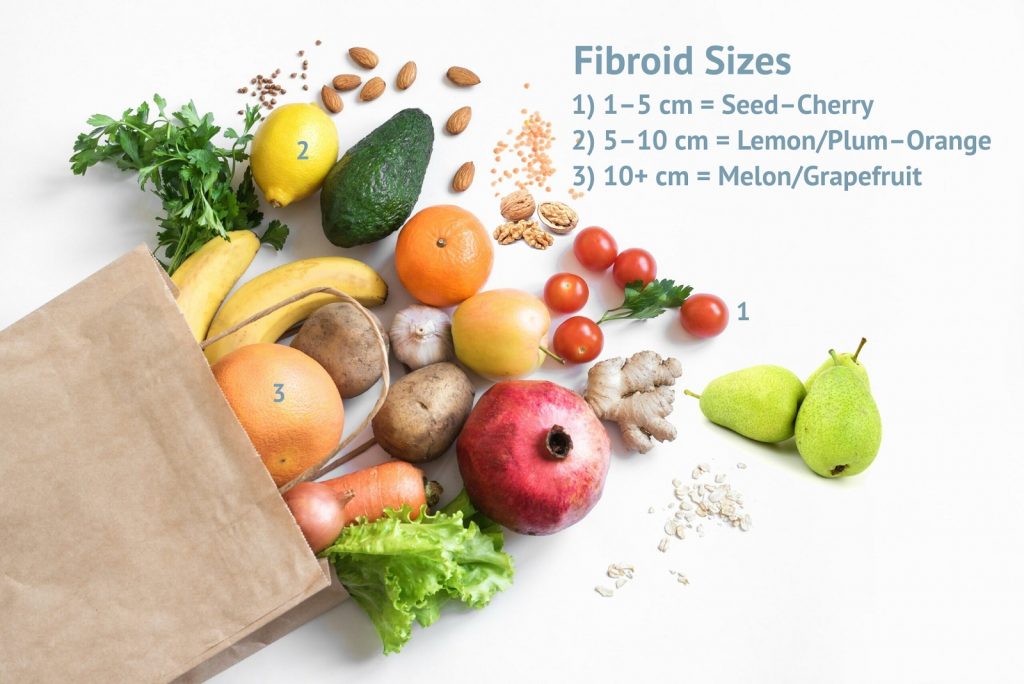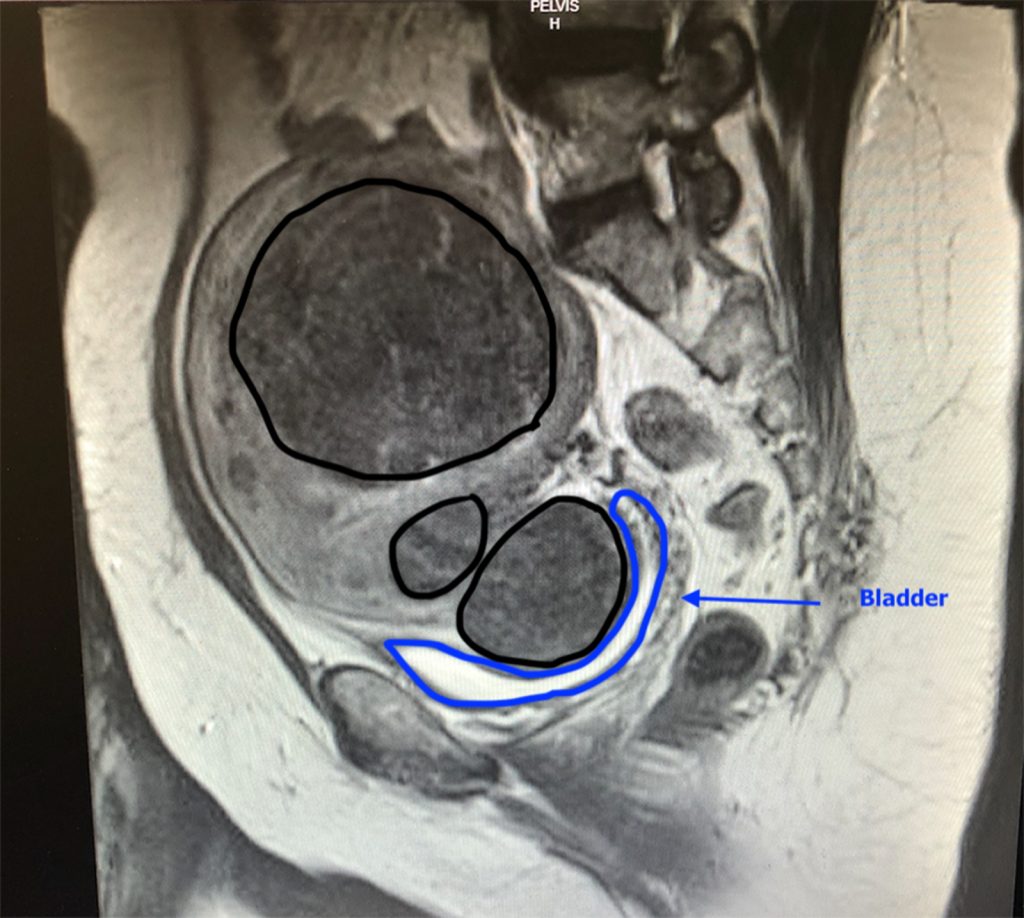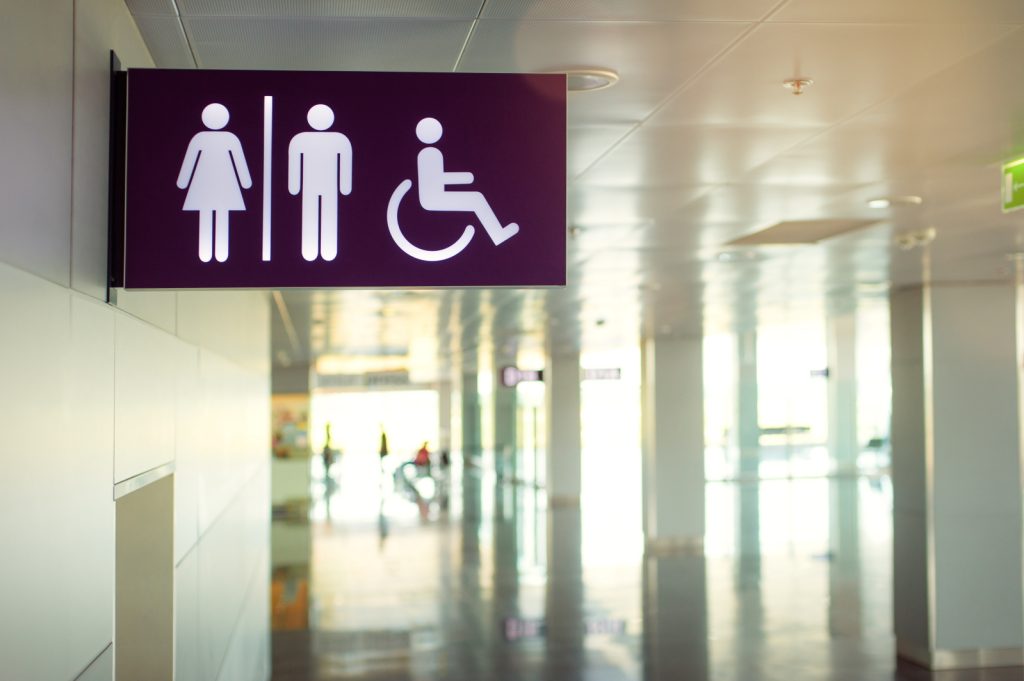Stephanie has lived with uterine fibroids for years. Because she wasn’t in any pain at first, it was simply something she and her gynecologist decided they would keep an eye on. But that all changed last year when she began experiencing heavy menstrual bleeding, abdominal pain, and bloating—all symptoms her OBGYN warned might happen. Another symptom Stephanie didn’t anticipate was a surge in bladder problems such as frequent urination. One minute, she was fine; the next, she felt an urgent need to pee. In recent weeks, that urinary frequency has caused her to wake up three or four times a night to go to the bathroom. Occasionally, she can’t “go” despite the feeling of a full bladder.
If bladder problems with fibroids, like frequent urination, is happening to you, you’re not alone. Researchers estimate that 70-80% of all women develop fibroids between the ages of 35 and 54. These benign tumors that develop from the muscle tissue of the uterus can develop in different locations, differ in size, and either stay that way or grow at different rates. While some women are asymptomatic, others experience a variety of painful and life-altering symptoms. This includes urinary issues, especially as their fibroids grow and put more pressure on the uterus and bladder. Here are some of the symptoms reported by fibroid patients.
Bladder Problems Reported by Fibroid Patients
- Frequent urination
- Bowel or bladder dysfunction
- Difficulty urinating despite feeling of full bladder
- Heaviness in lower abdomen or pelvis
- Debilitating pelvic pain and pressure
- Urgency incontinence
- Feelings of bloating or constipation
- Feeling of rectal fullness
About Uterine Fibroids and Bladder Problems
Urinating is our body’s way of removing waste once the bladder is full. Healthy people urinate 6-7 times per day on average, though they may need to go more often after drinking a lot of fluids. This is completely normal; in fact, you may find yourself getting up once at night for a bathroom break and then having to urinate several times throughout the day. If you need to urinate more often than that, say 9-12 times within 24 hours, you may have what’s called frequent urination, or urinary frequency.
Has this happened to you: You’re getting up 3-4 times a night and having the feeling during the day that if you don’t go to the bathroom immediately, you may have an accident? This urge may come on suddenly and without warning, quickly disrupting a person’s normal routine as well as their ability to get a full night’s sleep. This is why getting to the bottom of your frequent urination issue is so important.
There are a variety of underlying conditions that may be causing your urinary frequency, including:
- Pregnancy
- Urinary tract infection
- A bladder tumor
- Interstitial cystitis
- Certain medications
- Neurological problems
But if all those conditions have been ruled out, what you may be experiencing is frequent urination with fibroids. And here’s why: Fibroid symptoms can be directly tied to where they are located, their size, and how many fibroids are present. Size is a concern when it comes to bladder problems because as a fibroid grows, it becomes a large, heavy mass that causes the uterus to expand while also pressing against the bladder. As a result, the bladder’s capacity to hold urine decreases, and the chance for urine to be blocked increases.
To give you a better picture of fibroid growth, here is what fibroid sizes can look like:
- Small fibroids — Between 1 cm and 5 cm. Basically, the size of a small seed to a cherry.
- Medium fibroids — Between 5 cm to 10 cm. Can be the size of a plum to an orange.
- Large fibroids — Greater than 10 cm. The size of a melon, grapefruit, watermelon, or a small pumpkin.

Fibroid location is also important. The Office on Women’s Health breaks fibroids down into four main types based on location: subserosal (outside the uterine walls), pedunculated (hanging by a thin stalk outside the uterus), intramural (inside the uterine wall), and submucosal (under the uterine lining and into the uterine cavity).
Any of these types can create a domino effect that can lead to a variety of symptoms—including bladder problems.

What Are My Next Steps?
If you are experiencing unexplained urinary frequency, incontinence, or are having difficulties “going” when the urge to pee is present, it is best that you visit with your doctor. If there are other telltale fibroid symptoms present, your physician may refer you to a fibroid specialist, such as an interventional radiologist, for more guidance. In addition, an ultrasound can show if you have fibroids in your uterus and can give an idea of the size of each one. However, an MRI is the best imaging technique because it clearly shows fibroids that are not visible on ultrasound and provides the most detail when it comes to the size and position of the fibroids.
At Fibroid Institute Texas, we specialize in Uterine Fibroid Embolization (UFE) for the treatment of fibroids and symptoms such as frequent urination with fibroids. For years, the standard method of care for fibroids was fibroid surgery such as a hysterectomy and myomectomy. In some cases, these still are the recommended treatment option. But in today’s world of evolving technology, it is always wise to seek a second opinion where appropriate.
UFE is a minimally invasive procedure that only takes about an hour and requires no surgery. With UFE, the experienced fibroid specialists at Fibroid Institute insert small particles through a tiny catheter at the wrist using image-guided interventional radiology. The particles are introduced through the uterine arteries into the fibroid vessels, blocking the blood flow to the fibroids. By cutting off blood flow to all fibroids, the fibroids shrink and die so that you can get back to your lifestyle and normal activities quickly.
Advantages of UFE at Fibroid Institute include:
- Covered by most major medical insurance
- No hospital stay
- Shorter recovery period (average of one week)
- No incision
- Uterus is spared
- All fibroids may be treated at the same time
- Tiny wrist puncture, no need for vaginal access
- Over 90% effective in reducing symptoms

Urinary Frequency from Fibroids Can Be a Thing of the Past
Do you have frequent urination with fibroids? Are you interested in learning more about UFE for fibroid treatment? Most people would prefer to avoid surgery if there is an alternative out there that can help with their fibroid pain. Educate yourself about non-surgical fibroid treatment at Fibroid Institute.
The expert fibroid doctors and specialized team at Fibroid Institute have helped thousands of women discover the joys of not only living fibroid free but also ridding themselves of life-altering symptoms such as heavy menstrual bleeding and urinary frequency. Just imagine what it will feel like to sleep through the night or go out with friends without having to worry about where the nearest bathroom is. With each UFE procedure, patients are empowered to achieve their full potential without being limited by fibroid symptoms.
You will need a formal consultation to determine if you are a candidate before scheduling your procedure. Call for a telehealth consult or an in-office appointment at our Dallas fibroid clinics at 214-838-6440 or Houston fibroid clinics at 713-903-3733 or complete the form below.
"*" indicates required fields
Fibroid Institute Texas serves the Dallas and Houston areas including Fort Worth, Grand Prairie, HEB, Arlington, Hutchins, Irving, Duncanville, DeSoto, Cedar Hill, Lancaster, Cockrell Hill, Highland Park, University Park, Park Cities, Garland, Mesquite, Richardson, Dallas, Sherman, Houston, Sugar Land, Katy, Webster, Clear Lake, The Woodlands, Universal City, Spring, Kingwood, Stafford, Conroe, Texas City, Cypress, League City, Bellaire, Addison, Carrollton, Plano, Frisco, McKinney, Allen, and more.
Prior to starting any new treatment or if you have questions regarding a medical condition, always seek the advice of your doctor or other qualified health provider. This information is not a substitute for professional medical advice.

